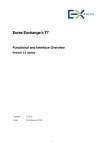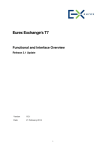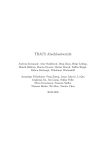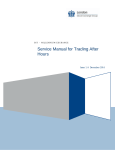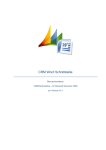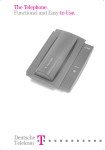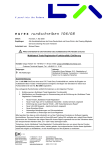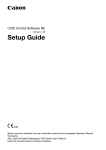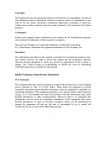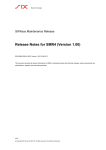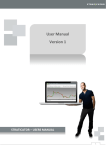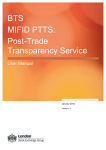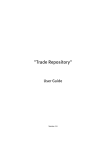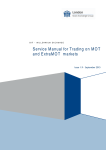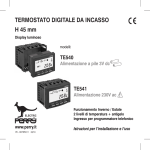Download "service manual"
Transcript
Eurex Exchange’s T7 Functional and Interface Overview Release 3.0 Update Version V3.0.1 Date 03 August 2015 1 Eurex Exchange’s T7 Eurex Frankfurt AG Functional and Interface Overview V3.0.1 © Eurex 2015 Deutsche Börse AG (DBAG), Clearstream Banking AG (Clearstream), Eurex Frankfurt AG, Eurex Clearing AG (Eurex Clearing) as well as Eurex Bonds GmbH (Eurex Bonds) and Eurex Repo GmbH (Eurex Repo) are corporate entities and are registered under German law. Eurex Zürich AG is a corporate entity and is registered under Swiss law. Clearstream Banking S.A. is a corporate entity and is registered under Luxembourg law. U.S. Exchange Holdings, Inc. and International Securities Exchange Holdings, Inc. (ISE) are corporate entities and are registered under U.S. American law. Eurex Frankfurt AG (Eurex) is the administrating and operating institution of Eurex Deutschland. Eurex Deutschland and Eurex Zürich AG are in the following referred to as the “Eurex Exchanges”. All intellectual property, proprietary and other rights and interests in this publication and the subject matter hereof (other than certain trademarks and service marks listed below) are owned by DBAG and its affiliates and subsidiaries including, without limitation, all patent, registered design, copyright, trademark and service mark rights. While reasonable care has been taken in the preparation of this publication to provide details that are accurate and not misleading at the time of publication DBAG, Clearstream, Eurex, Eurex Clearing, Eurex Bonds, Eurex Repo as well as the Eurex Exchanges and their respective servants and agents (a) do not make any representations or warranties regarding the information contained herein, whether express or implied, including without limitation any implied warranty of merchantability or fitness for a particular purpose or any warranty with respect to the accuracy, correctness, quality, completeness or timeliness of such information, and (b) shall not be responsible or liable for any third party’s use of any information contained herein under any circumstances, including, without limitation, in connection with actual trading or otherwise or for any errors or omissions contained in this publication. This publication is published for information purposes only and shall not constitute investment advice respectively does not constitute an offer, solicitation or recommendation to acquire or dispose of any investment or to engage in any other transaction. This publication is not intended for solicitation purposes but only for use as general information. All descriptions, examples and calculations contained in this publication are for illustrative purposes only. Eurex and Eurex Clearing offer services directly to members of the Eurex exchanges respectively to clearing members of Eurex Clearing. Those who desire to trade any products available on the Eurex market or who desire to offer and sell any such products to others or who desire to possess a clearing license of Eurex Clearing in order to participate in the clearing process provided by Eurex Clearing, should consider legal and regulatory requirements of those jurisdictions relevant to them, as well as the risks associated with such products, before doing so. Eurex derivatives are currently not available for offer, sale or trading in the United States or by United States persons (other than EURO STOXX 50® Index Futures, EURO STOXX 50® ex Financials Index Futures, EURO STOXX® Select Dividend 30 Index Futures, EURO STOXX® Index Futures, EURO STOXX® Large/Mid/Small Index Futures, STOXX® Europe 50 Index Futures, STOXX® Europe 600 Index Futures, STOXX® Europe 600 Banks/Industrial Goods & Services/Insurance/Media/Travel & Leisure/Utilities Futures, STOXX® Europe Large/Mid/Small 200 Index Futures, Dow Jones Global Titans 50 IndexSM Futures (EUR & USD), DAX®/MDAX®/TecDAX® Futures, SMIM® Futures, SLI Swiss Leader Index® Futures, MSCI World/Europe/Japan/AC Asia Pacific ex Japan Index Futures and VSTOXX® Futures as well as Eurex inflation/commodity/weather/property and interest rate derivatives). Trademarks and Service Marks Buxl®, DAX®, DivDAX®, eb.rexx®, Eurex®, Eurex Bonds®, Eurex Repo®, Eurex Strategy WizardSM, Euro GC Pooling®, FDAX®, FWB®, GC Pooling®,,GCPI®, MDAX®, ODAX®, SDAX®, TecDAX®, USD GC Pooling®, VDAX®, VDAX-NEW® and Xetra® are registered trademarks of DBAG. Phelix Base® and Phelix Peak® are registered trademarks of European Energy Exchange AG (EEX). All MSCI indexes are service marks and the exclusive property of MSCI Barra. RDX® is a registered trademark of Vienna Stock Exchange AG. IPD® UK Annual All Property Index is a registered trademark of Investment Property Databank Ltd. IPD and has been licensed for the use by Eurex for derivatives. SLI®, SMI® and SMIM® are registered trademarks of SIX Swiss Exchange AG. The STOXX® indexes, the data included therein and the trademarks used in the index names are the intellectual property of STOXX Limited and/or its licensors Eurex derivatives based on the STOXX® indexes are in no way sponsored, endorsed, sold or promoted by STOXX and its licensors and neither STOXX nor its licensors shall have any liability with respect thereto. Dow Jones, Dow Jones Global Titans 50 IndexSM and Dow Jones Sector Titans IndexesSM are service marks of Dow Jones & Company, Inc. Dow Jones-UBS Commodity IndexSM and any related sub-indexes are service marks of Dow Jones & Company, Inc. and UBS AG. All derivatives based on these indexes are not sponsored, endorsed, sold or promoted by Dow Jones & Company, Inc. or UBS AG, and neither party makes any representation regarding the advisability of trading or of investing in such products. All references to London Gold and Silver Fixing prices are used with the permission of The London Gold Market Fixing Limited as well as The London Silver Market Fixing Limited, which for the avoidance of doubt has no involvement with and accepts no responsibility whatsoever for the underlying product to which the Fixing prices may be referenced. PCS® and Property Claim Services® are registered trademarks of ISO Services, Inc. Korea Exchange, KRX, KOSPI and KOSPI 200 are registered trademarks of Korea Exchange Inc. BSE and SENSEX are trademarks/service marks of Bombay Stock Exchange (BSE) and all rights accruing from the same, statutory or otherwise, wholly vest with BSE. Any violation of the above would constitute an offence under the laws of India and international treaties governing the same. The names of other companies and third party products may be trademarks or service marks of their respective owners. 2 Eurex Exchange’s T7 Eurex Frankfurt AG Functional and Interface Overview V3.0.1 Content 1 Introduction 5 1.1 Purpose of this document 1.2 Further reading 5 5 2 Main Components 2.1 2.2 2.3 2.4 2.5 6 Multiple Markets Participant, Business Unit, User Products and Instruments Complex Instruments Product and Instrument States 6 6 7 8 10 3 Functionality 11 3.1 Orders 3.2 Quotes 3.3 Matching 3.3.1 Allocation schemes 3.3.2 Synthetic matching 3.3.3 Volatility Interrupts 3.3.4 Self-Match Prevention (SMP) 3.4 Trade Traceability 3.5 Clearing 3.6 Safeguards for Participants 11 12 13 13 13 13 13 14 14 14 4 Interfaces 16 4.1 Functions compared to Interfaces 4.2 Trading Interfaces 4.2.1 The Eurex Enhanced Trading Interface 4.2.2 The Eurex FIX Gateway 4.3 The Eurex Market Data Interfaces 4.3.1 Eurex Market Data Interface and Eurex Enhanced Market Data Interface 4.3.2 Eurex Enhanced Order Book Interface 4.4 Reference Data 4.4.1 Eurex Reference Data Interface (Eurex RDI) 4.4.2 Eurex Reference Data File (Eurex RDF) 4.4.3 Reference Data in the market data interfaces 4.5 Eurex Extended Market Data Service 4.6 Graphical User Interfaces 4.7 Reports 5 Appendix 17 18 18 20 21 21 21 22 22 22 22 22 22 23 24 5.1 Product and Instrument State Details 5.1.1 The Instrument States 5.1.2 The Product states 5.1.3 Fast Market 5.1.4 Instrument Listing Status 5.2 Traceability 24 24 26 27 27 28 3 Eurex Exchange’s T7 Eurex Frankfurt AG Functional and Interface Overview V3.0.1 5.3 Order Traceability 5.3.1 Technical Notes: 5.3.2 Quote Traceability 5.3.3 Trade Reversal 5.3.4 Preliminary and Final Trade Confirmations for Variance Futures 5.3.5 Complex Instrument Trades 5.4 Trade Concepts 5.4.1 Direct Simple Instrument Match 5.4.2 Direct Complex Instrument Match 5.4.3 Synthetic Match 5.5 Clearing Fields 5.5.1 Orders 5.5.2 Quotes and Orders Entered Using the Short Layout 5.5.3 Client Free Text 5.5.4 Clearing Account Rules 6 Change log 28 28 30 31 31 33 34 34 36 36 38 38 39 41 42 43 4 Eurex Exchange’s T7 Eurex Frankfurt AG Functional and Interface Overview V3.0.1 1 Introduction Eurex Exchange’s T7 is a state-of-the art trading system that is used to operate the Eurex and EEX derivative exchanges. By taking advantage of new technologies, T7 has significantly improved throughput and reduced latency. Eurex Exchange´s T7 performs on-exchange trading functions, while Eurex Clearing’s C7 and the Eurex Clearing classic system provide clearing and Eurex Trade Entry Services. Trades executed on T7 are passed to the Eurex Clearing classic system to be processed for clearing. T7 offers improved performance with reliable connectivity, enriched trading functionality, as well as a faster time-to-market. 1.1 Purpose of this document This document describes the main capabilities, and in general terms, how Eurex Exchange’s T7 functions. The following areas are described: • Main components. • New and changed functionality. • Descriptions of the interfaces available. In addition, this document contains detailed information about states, traceability, trade concepts, and clearing fields in the appendix. Content changes compared to previous document versions are listed in the change log at the end of the document. 1.2 Further reading The following documents provide additional information: • Eurex Functional Reference. • Eurex Exchange’s T7 Release 3.0 Notes. • Eurex Participant and User Maintenance – Manual. • Eurex Enhanced Trading Interface – Manual. • Eurex Market and Reference Data Interfaces – Manual. • Eurex Enhanced Order Book Interface – Manual. • Eurex Extended Market Data Service – Manual. • Eurex FIX Gateway – FIX Manuals. • Eurex Trader and Admin GUI – Manual. • Eurex Trade Entry Services – Manual. • Common Report Engine (CRE), User Guide. These documents are available on the Eurex website www.eurexchange.com > Technology > Eurex Exchange’s T7 > System Documentation. Additionally, please refer to the Eurex Clearing FIXML Interface Specification available on the Eurex Clearing website www.eurexclearing.com > Technology > Eurex Clearing Classic System > System Documentation for more information on Trade Confirmations in the clearing system. 5 Eurex Exchange’s T7 Eurex Frankfurt AG Functional and Interface Overview V3.0.1 2 Main Components The following chapter describes the main components of Eurex Exchange’s T7. 2.1 Multiple Markets Eurex Exchange’s T7 is able to operate multiple markets on one technical instance, independently of each other. It is currently used by the Eurex Exchange and EEX European Energy Exchange for derivatives trading. Participants, products and trading rules belong to exactly one market. Subject to contractual agreements, participants of one market may be able to access products of another market, such as with EEX cooperation products. 2.2 Participant, Business Unit, User Eurex Exchange’s T7 has a three level hierarchy, which is slightly different to the member and user hierarchy in the Eurex Clearing classic system: • Participant: An entity accessing T7, which can be an exchange participant, a clearing member, or a service provider. • Business Unit: In T7, a participant may have several business units, which are independent of each other. There are two types of business units: • A Trading Business Unit, which is used for trading. • A Clearing Business Unit, which is used by clearing members to receive trade confirmations from its trading business units and from its non-clearing members. Each non-clearing member initially has just one trading business unit and each clearing member just one trading and one clearing business unit. • User(s): A business unit can have multiple users. A user can be a trading user and/or an administrator. 6 Eurex Exchange’s T7 Eurex Frankfurt AG Functional and Interface Overview V3.0.1 A user can be assigned to a Trader Group. Within the trader group there are three user levels: • A “trader” can only modify/delete orders that it owns. An order entered into T7 always belongs to the entering trader. • A “head trader” can modify/delete orders owned by any trader in the same trader group, but not for an order owned by a trader in a different trader group • A “supervisor” can modify/delete orders owned by any trader in the same business unit. • It is possible to mass delete orders, across all sessions if the trader/user has the appropriate permission. Quote ownership does not depend on the trader group, refer to section 3.2. With T7, users are configured by the participant via the Eurex Admin GUI and have to be registered via the Member Section. Trading users must be activated by the exchange. A participant can manage which functions the users are allowed to perform. In T7, the various trading functions are grouped into different “Roles” such as trader, market maker, market maker protection and service administrator. A participant can assign these roles to its users and a user can be given more than one role. A user can have different roles for each product assignment group. For example: • A trader can have the “trader role” for one product assignment group, while having a “market maker role” in another. • A “trader role” is enabled to maintain orders, but is not enabled for maintaining quotes, which is part of the “market maker role”. • A user only having the “trading view” can see trading information, but cannot enter orders or quotes. • A user with a “service administrator role” is enabled to maintain users. Please refer to the “Participant and User Maintenance Manual” for further details. 2.3 Products and Instruments 1 Each market in Eurex Exchange’s T7 has the following hierarchy: Product Assignment Groups , Products and Instruments. A product belongs to one product assignment group. The term “instrument” is used to refer to the object which is traded. The Eurex Reference Data Interface (Eurex RDI) and the Reference Data File describe each product, each instrument and their trading parameters, refer to section 4.4. 1 For instance, the product assignment group “German Interest Rate Futures & Options“ contains the products FGBL, FGBM, FGBS, FGBX, OGBL, OGBM, and OGBS. A simple instrument would be FGBL DEC 2014. 7 Eurex Exchange’s T7 Eurex Frankfurt AG Functional and Interface Overview V3.0.1 2.4 Complex Instruments Simple instruments are individual futures contracts or options series. Complex instruments facilitate the simultaneous trading of two or more simple instruments. The simple and complex instruments are grouped into Instrument Types: • Simple instruments: Individual futures contracts or options series. • Futures spread: All calendar spread combinations for futures. • Standard options strategy: Strategies with up to four legs, which conform to standard rules (e.g. BUL, BER, STD). • Non-standard options strategy: Any combination of simple options instruments, not covered by a standard options strategy, with up to five legs. • Option volatility strategy: Volatility strategies with up to five legs (e.g. C–U, P+U, BUL–U). • Standard futures strategy: Analogous to standard options strategy. Initially, T7 supports two standard futures strategies for EURIBOR: Futures Butterfly and Futures Condor. • Pack and bundle: Futures strategies containing consecutive quarterly maturity dates of the EURIBOR futures • Strip: Futures strategy similar to packs and bundles with at least two and at most 20 legs. • Inter-product spread: Combination of contracts that belong to different futures products of the same market. This functionality is currently used by the European Energy Exchange (EEX). Typically, complex instruments are requested by traders, however, some futures spreads, packs and bundles and inter-product spreads are created by the exchange by default. Complex instruments requested by traders with open orders valid beyond the current trading day will be available the next day. It is possible to have different trading parameters per instrument type, for example allocation schemes and price validations. Therefore, instruments belonging to different instrument types of the same 8 Eurex Exchange’s T7 Eurex Frankfurt AG Functional and Interface Overview V3.0.1 product can vary in their trading behavior. The order execution notification for a complex instrument order contains the order’s trade price and quantity, as well as the individual leg prices and leg quantities, while the trade confirmations are always based on simple (leg) instruments, implying that there are separate trade confirmations at least for each leg in case of a complex instrument match. 9 Eurex Exchange’s T7 Eurex Frankfurt AG Functional and Interface Overview V3.0.1 2.5 Product and Instrument States The trading states of an exchange give the trading day a structure; they also control what activities are available to traders and what the exchange system does. Eurex Exchange’s T7 applies trading states at both the product level and at the instrument level. Instruments of the same product can be in different instrument states. Product states give structure to the trading day and control general access to the products, while instrument states control order/quote maintenance, execution and availability of market information. Instrument states enable greater flexibility with auctions. The following diagram shows a typical trading day. Note how product state changes are usually accompanied by instrument state changes, but there are also instrument state changes without a product state change, particularly those related to auctions. Refer to section 5.1 for product and instrument state details. 10 Eurex Exchange’s T7 Eurex Frankfurt AG Functional and Interface Overview V3.0.1 3 Functionality This section describes key aspects of the functionality provided by Eurex Exchange’s T7. 3.1 Orders T7 supports multiple types of orders. These are specified with order attributes at order entry. The combinations of order attributes that are permitted can differ per product and instrument type. For example, a “regular limit order” has the order type attribute “regular”, the price condition “limit”, and any of the time validities such as good-for-day. A “market order” would be the same, except for having the price condition attribute “market”. The Book-or-Cancel order is an order that is accepted by the system only if it does not trade on entry. T7 also supports Stop Limit orders and Stop Market orders. Note: for the time being no product will allow Stop Limit orders. Orders for all simple and complex instrument types, including options strategies, can have a validity of more than the current day. For all orders, two mandatory technical order attributes have to be set. These order attributes cannot be changed during the lifetime of an order: 1. Persistent or Non-persistent Orders: • • Persistent Orders are re-instated at the start of the next business day depending on their order validity, or after a failure of the trading system. Non-persistent orders will be deleted end of a business day, in case of session loss, market resets, or trading interrupts (volatility interrupts, state changes to halt). 2. Standard or Lean Orders: • For standard orders, the complete order history can be recovered via retransmission requests. This order data is visible to all low-frequency sessions (refer to section 4.2.1) belonging to the same business unit (via subscription to the listener data broadcast). Standard orders can be persistent or non-persistent. • For lean orders, only the execution notifications and unsolicited events can be recovered (via retransmission requests on the session data channel). All data on lean orders are visible only to the session that submitted the order. Lean orders are always non-persistent. For further details, please refer to the “Eurex Enhanced Trading Interface Manual”. Market makers and high-frequency traders can improve system performance by selecting lean and non-persistent orders, as is done in the high frequency sessions, refer to section 4.2. There are two different price validations for orders and quotes, both considering the most recent best bid and best ask price. • A “price reasonability check” helps to ensure that the price does not differ significantly from the market. A trader submitting an order or mass quote entry can decide individually for each order or mass quote entry, whether it is subjected to a price reasonability check or whether the check is skipped. If the best bid and best ask prices are not available, an additional reference price (last traded price, theoretical price) is taken into account. If the additional reference price is also not available, the incoming order/quote is: • Accepted without performing a price validation and without additional notification in case the submitting trader chooses an optional price reasonability check, or 11 Eurex Exchange’s T7 Eurex Frankfurt AG Functional and Interface Overview V3.0.1 • • • Rejected in case the submitting trader chooses a mandatory price reasonability check with a specific notification to the entering trader. An “extended price range check” (also referred to as a fat finger check) ensures that the price does not cross through the market to such an extent as to be considered an erroneous price. The extended price range check cannot be skipped by the entering trader. However, if a price reasonability check requested by a trader was successfully applied, the extended price range check is skipped. Usually, the price range applied by the extended price range check is larger than the price range applied by the price reasonability check. 3.2 Quotes Quotes may be used to maintain a single bid/offer in multiple instruments within a product. The following applies for quotes: • Quotes belong to the session on which they are entered, refer to section 4.2. A business unit can have multiple sessions, each with its own quotes. • The “mass quote” function allows the participant to enter, modify and delete multiple quotes of a session simultaneously. This function is available for both, options and futures. • T7 provides “quote entry” to replace an existing quote with the new quote. This is done by starting a new quote life cycle with an accumulated traded quantity set to zero. It also provides “quote modification”, which refers to an existing quote and preserves the accumulated traded quantity. The priority timestamp of a quote stored in the order book is changed when the price is changed or the open quote quantity is increased. • The “delete all quotes” function can be used to delete all quotes of a session in a product. • Quotes for complex instruments are supported and can be mixed with quotes for simple instruments inside a single “mass quote” transaction. • An incoming or a modified quote side which fails the price reasonability check or the extended price range validation results in the complete deletion of the quote: i.e. both sides of the quote, including existing old sides in the book, are deleted. • Quotes are automatically deleted when an instrument changes to “closed” or “restricted”, which occurs at the end of the day; or when an instrument is suspended by market supervision, or has expired. • Quotes are always deleted in case of a volatility interrupt. • A complete session can be inactivated and re-activated for quoting. This feature can be applied to all quotes of a session, filtered by product, or by product/instrument type. When quotes of a session are inactivated they are unavailable for matching, but can be updated while remaining inactive. During the time of the inactivation, any new quotes entered into the session will also be inactivated. When quotes are (re-)activated they receive a new matching time priority. The market maker protection functionality (refer to 3.6) uses this inactivation function rather than quote deletion. 12 Eurex Exchange’s T7 Eurex Frankfurt AG Functional and Interface Overview V3.0.1 3.3 Matching When trading an incoming order against the book, the best priced orders in the book are traded first. When there are multiple orders at the best price, the allocation scheme specifies how the quantity of the incoming order is allocated to those book orders. Eurex Exchange’s T7 supports the following allocation schemes, which can be different per product and instrument type. 3.3.1 Allocation schemes • Time allocation: The quantity of the incoming order is allocated to the oldest book order first. If there is any remainder then it is moved to the next oldest order, until the quantity of the incoming order is exhausted or all orders at the best price have been executed. • Pro-rata allocation: The allocated quantity of the incoming order is shared amongst all book orders at the best price. The allocation is proportional to the size of each book order. All book orders at the best price are considered in the allocation. Time-pro-rata allocation: The allocation of an individual order is based on its order size as well as on the order priority time, combining aspects of pro-rata and time allocation. In that way best price orders with an older order priority time receive a higher share of the quantity of the incoming order, at the expense of orders with younger order priority times, and there are potentially less book orders involved, compared to the pro-rata allocation. • 3.3.2 Synthetic matching Synthetic matching is based on the combination of different order book sides being used to generate a synthetic order in simple or spread instruments competing for execution with the outright orders. It is possible for an incoming order to be executed against a synthetic book order, generating a synthetic match event, instead of being executed against an outright order generating a direct match event. For some additional information refer to section 5.4.3. 3.3.3 Volatility Interrupts A volatility interrupt leads to a volatility auction state. The handling of volatility interrupts in T7 is as follows: • The volatility interrupt is triggered before the affected order is matched outside the volatility range. • Volatility interrupts at both the instrument and the product level are supported. • Volatility interrupts are possible for both options and for futures. 3.3.4 Self-Match Prevention (SMP) Self-match prevention is an optional functionality which allows a business unit to prevent that certain own orders of the same instrument match against each other. This functionality can be used by filling in the numeric SMP-ID (field MatchInstCrossID in Eurex ETI and Eurex FIX Gateway, field CrossID in the Eurex Trader GUI) in the respective order or quote message. The SMP-ID will be checked on a business unit level. Its setup and usage lies within a business unit’s responsibility. SMP is: • Offered via all trading interfaces (Eurex ETI, Eurex FIX Gateway) including the Trader GUI. • Supported for orders (including Stop Orders, Market Orders, One-Cancels-the-Other Orders) and quotes. • Performed during the instrument state Continuous only. 13 Eurex Exchange’s T7 Eurex Frankfurt AG Functional and Interface Overview V3.0.1 • Supported for all matching allocation schemes. • Not supported for synthetic matching, i.e. SMP will not prevent matches of orders/quotes in instruments different to the incoming order’s instrument. When an incoming order (newly added, modified, triggered order/quote, or reactivated quote) and a book order (or quote side) would match against each other, T7 checks whether they are owned by the same business unit and whether they carry the same user supplied SMP-ID. If that is the case, the match between the two orders is prevented and the quantity which would have matched is cancelled from the open order quantity, for both the incoming order and the book order. Afterwards, the incoming order is allowed to match further only on the same price level in case of sufficient quantity. After matching completed on that price level, any remaining open quantity left for the incoming order is deleted. In case there is quantity left from the book order after its reduction because of SMP, this quantity remains in the book. 3.4 Trade Traceability Eurex Exchange’s T7 provides trade traceability, allowing orders to be linked to executions, trade confirmations, and trades in clearing for simple instruments and complex instruments. Refer to section 5.2. For matching and trade concepts, refer to section 5.4. 3.5 Clearing Trade information is forwarded to the Eurex Clearing classic system. All clearing and settlement functions are performed there and in Eurex Clearing's C7.In addition, Eurex Exchange’s T7 offers participants several clearing related fields, for both internal participant use and for use by the clearing system (refer to section 5.5). Eurex Exchange’s T7 uses a trade enrichment rule concept as a simple index table of rules which has to be referenced on transaction entry by the originator. For further details refer to section 5.5 and document “Eurex Trader GUI and Eurex Admin GUI Manual”. 3.6 Safeguards for Participants Participant safeguard functions are available in Eurex Exchange’s T7 including: • • • • Transaction Size Limits (maximum order quantity) enables the participant to restrict the quantity at order and quote entry. Market maker protection (MMP) features: • MMP is available for both futures and options. • MMP can be applied either on the product level or on the product/instrument type level. • MMP uses quote inactivation rather than quote deletion. • MMP can be maintained separately via Eurex Trader and Eurex Admin GUIs and Eurex ETI. • Percentage, volume, delta and vega limits can be used for MMP. Pre-Trade limits, enables the participant to set limits on the number of open orders and quote sides stored in the order book, to help prevent accidental massive submission of orders from algorithmic trading and/or order routing systems. Manual stop/release of trading is available, the effect of this is on a participant level, on a 14 Eurex Exchange’s T7 Eurex Frankfurt AG Functional and Interface Overview V3.0.1 business unit level, or for an individual trader. Manual stop/release can be performed by an exchange participant, by a clearing member (via the existing Eurex interfaces), or by the clearing house. • Advanced Risk Protection functionality is supported; it can provide warnings, slow or stop a participant if certain limits are exceeded. • Price validations for orders and quotes, refer to section 3.1. 15 Eurex Exchange’s T7 Eurex Frankfurt AG Functional and Interface Overview V3.0.1 4 Interfaces Eurex Exchange’s T7 provides participants with a portfolio of interfaces: Gateways act as entry points for transactions, market and reference data is distributed using multicast and a GUI solution is available. One general design principle of the interfaces is to minimize the exchanges’ effect on the participants. Participants do not need to install exchange hardware or software components. T7 can be accessed without the need for specific hardware, operating system, programming language, and compiler versions, as long as they support the general communication components, like TCP/IP and IP multicast. Eurex Exchange’s T7 supports the following interfaces: • Eurex Enhanced Trading Interface (Eurex ETI): The Eurex ETI is the high performance trading interface designed for participants who require the highest throughput and the lowest latency. The Eurex ETI supports full trading functionality, including market making (quoting). • Eurex FIX Gateway: The Eurex FIX Gateway is intended for participants who require a standard FIX connection to the exchange. Market making (quoting) functionality is not supported by this interface. • Eurex Market Data Interface (Eurex MDI): Provides netted price level aggregated market data using multicast technology. • Eurex Enhanced Market Data Interface (Eurex EMDI): Provides un-netted price level aggregated market data. • Eurex Enhanced Order Book Interface (Eurex EOBI): Provides, for selected futures only, the entire visible order book by publishing information on each individual order and quote in un-netted manner, along with all on-exchange executions and state information. • Eurex Reference Data Interface (Eurex RDI): This interface provides reference data via high bandwidth connections, including intra-day updates. Some reference data is also disseminated via Eurex MDI and the incremental channel of Eurex EMDI • Eurex Extended Market Data Service (Eurex EMDS): This interface provides public off-book trade prices, intraday settlement prices, adjusted open interest and underlying ticker data. • GUIs: Graphical user interfaces that provide direct human access to the system. • Eurex Trader GUI: Basic trading functions for orders and Eurex Trade Entry Services. Quoting is not supported. • Eurex Admin GUI: Administration functions, for example, user maintenance. • Common Report Engine: Trading reports, audit trail reports, and reference data files (Eurex RDF) are provided exclusively via the common report engine. Historical information of previous days is not provided by the interfaces, except for public news. 16 Eurex Exchange’s T7 Eurex Frankfurt AG Functional and Interface Overview V3.0.1 4.1 Functions compared to Interfaces The following table provides an overview; refer to the next sections for more information. Eurex Core Trading Market 1 Making 2 Info 3 Trade Entry Market Data 4 Reference Data 5 Admin Reports Services Eurex ETI ✓ FIX Gateway ✓ ✓ ✓ Private risk control messages Eurex MDI ✓ New & deleted complex instruments Eurex EMDI ✓ New & deleted complex instruments Eurex EOBI6 ✓ New & deleted complex instruments ✓ Eurex RDI Off-book trade prices, intraday settlement prices, open interest, underlying ticker data Eurex EMDS Eurex Trader GUI Clearing Interfaces Eurex Admin GUI Common Report Engine ✓ Quote deletion, activation/ deactivation, protection maintenance ✓ ✓ ✓ ✓ ✓ Protection Maintenance ✓ ✓ FIXML 1 Order management, trade confirmations, complex instrument creation, cross request, quote request Quote management, market maker protection 3 Public news, private risk control messages 4 Public market data, on-exchange trade information, product and instrument states, quote and cross requests 5 User maintenance, password maintenance, PIN procedure, trade enrichment rule, stop trading, risk control actions 6 For selected futures only. 2 17 ✓ Eurex Exchange’s T7 Eurex Frankfurt AG Functional and Interface Overview V3.0.1 4.2 Trading Interfaces There are two types of trading interfaces: The Eurex Enhanced Trading Interface (Eurex ETI) and the Eurex FIX Gateway. Both are session oriented interfaces. Participants are requested to order their sessions from the exchange. Participant applications are connected to the trading system by opening a TCP session to an application gateway. 4.2.1 The Eurex Enhanced Trading Interface The Eurex Enhanced Trading Interface (Eurex ETI) is the high performance trading interface designed for participants who require the highest throughput and lowest latency. A participant must establish a TCP session to connect to Eurex Exchange’s T7. All application messages exchanged between the client and the Eurex ETI are close to the FIX V5.0 SP2 semantics, including all officially approved extension packs. A proprietary session layer is used to provide the highest flexibility. The Eurex ETI provides all trading functions of Eurex Exchange’s T7: • Order handling for simple and complex instruments. • Additional support of short order message layouts for simple instruments, which applies streamlined functionality to achieve a comparable latency to quotes. • Quote handling, including quote inactivation, for simple and complex instruments. • Execution notifications. • Market maker protection mechanisms. • Creation of complex instruments (strategies). • Request for quote. • Cross request. The Eurex ETI enables participants to subscribe to private trading data in broadcast form: • Drop copy of order events other than for lean orders (optional subscription). • Trade confirmation at a business unit level (optional subscription). The following trading support information is available for each session: • News messages from Eurex market supervision (optional subscription). • Private risk control messages (always sent). The Eurex ETI does not provide any market data, reference data, or administrative functions. Eurex ETI is a session oriented interface. Eurex ETI responds to each request on the same session after the request was submitted. It also sends unsolicited messages when there are changes or executions to any orders and quotes entered on that session. The Eurex ETI is based on the following general concepts: • Trade confirmations are the only legally binding information that a trade has occurred. • Orders are owned by the user. • Lean orders can only be modified through the same session, where they had been entered previously. • Quotes are owned by the session. • Order and quote responses as well as execution messages do not completely echo the data of the original order. Hence participant applications should save the details of each order and 18 Eurex Exchange’s T7 Eurex Frankfurt AG Functional and Interface Overview V3.0.1 quote sent. • No state recovery (inquiry) is supported; participant applications must keep track of the order book and use retransmission recovery and the order book replay, which is sent at start-of-day and in case of an exchange system failure (i.e. market reset). • For quotes and lean orders only the execution notifications and unsolicited events are recoverable. • For standard (non-lean) orders all order events are recoverable. • A listener broadcast contains order events for standard (non-lean) orders but not for lean orders (refer to 3.1). The Eurex ETI supports two session types: high-frequency (HF) and low-frequency (LF) sessions. Both session types differ in functionality: • The HF session only supports lean orders. Standard orders are rejected. A HF session does not support the subscription of broadcasts. • A LF session may also be used for the receipt of broadcasts; for example, listener broadcast or trade notifications at a business unit level/clearing member level. Orders in a LF session can be persistent or non-persistent, standard (non-lean) or lean, refer to 3.1. In order to protect its trading system, Eurex Exchange’s T7 has several measures in place to ensure that its most vital components are not harmed by a malfunctioning client application. In particular, the following technical transaction limits (throttle) are used for the respective combinations of environment, session type and capacity type: Environment Session type Capacity type Transactions/sec HF Full 150 HF Light 50 LF Full 150 LF Light 50 HF Full 20 HF Light 20 LF Full 20 LF Light 20 Production Simulation Additionally, all Eurex ETI sessions have an assigned disconnection limit of: • • 450, i.e. in case of more than 450 consecutive rejects due to exceeding the technical transaction limit for sessions with a throttle value of 150 txn/sec. 150, i.e. in case of more than 150 consecutive rejects due to exceeding the technical transaction limit for sessions with a throttle value of 50 txn/sec. For both limits all technical transactions are counted using a sliding window. Dedicated back-office Eurex ETI LF sessions are available to receive trade and listener broadcasts. This session type cannot be used to enter order/quotes. Please refer to the “Eurex Enhanced Trading Interface Manual” for further details. 19 Eurex Exchange’s T7 Eurex Frankfurt AG Functional and Interface Overview V3.0.1 4.2.2 The Eurex FIX Gateway The Eurex FIX Gateway is intended for participants that require a standard FIX connection to the exchange. The FIX Gateway will support two types of FIX sessions; Trading and Back-Office FIX Sessions. The interface is a point-to-point service based on the technology and industry standards TCP/IP, FIX and FIX Session Protocol. The session and application event models and messages are based on version 4.2 and 4.4 of the FIX Protocol. The Eurex FIX Gateway supports the following features of Eurex Exchange’s T7 via FIX trading sessions: • Order handling for simple and complex instruments. • Execution notifications are sent to the session on which the order was received. • Request for quote. • Cross request. • Enhanced support for mass deletion events (market reset, risk control events). • Creation of complex instruments (strategy). • Simplified handling of orders for multi-leg instruments due to enhanced security identification. Each Eurex FIX session has a technical transaction limit of 50 transactions per second. Dedicated back-office FIX sessions are available to receive trade confirmations and drop copies of standard orders at a business unit level. The FIX Gateway does not provide quote functionality, market data, reference data, or administrative functions. Please refer to the “FIX Gateway Manual” for further details. 20 Eurex Exchange’s T7 Eurex Frankfurt AG Functional and Interface Overview V3.0.1 4.3 The Eurex Market Data Interfaces Market data is available using multicast interfaces: • Eurex Enhanced Market Data Interface (Eurex EMDI) offers un-netted market data and requires a high bandwidth connection. • Eurex Market Data Interface (Eurex MDI) offers netted market data, with fewer order book and trade updates, requiring a lower bandwidth connection. • Eurex Enhanced Order Book Interface (Eurex EOBI) provides, for selected futures only, the entire visible order book by publishing information on each individual order and quote, along with executions and state information. It is the most granular source of market data. Eurex EOBI requires a 10GB connection and is available in co-location installations only. All data feeds are distributed over a number of IP multicast addresses. 4.3.1 Eurex Market Data Interface and Eurex Enhanced Market Data Interface The Eurex EMDI and Eurex MDI feeds follow FIX 5.0 SP2 semantics and are FAST encoded. Eurex EMDI uses out-of band recovery, while Eurex MDI uses in-band recovery. The following information is provided: • Order book depth aggregated by price levels. • Less price levels are provided on the Eurex MDI feed, which can be different to the number provided on the current Eurex system. • On-exchange trade information. • Product state and instrument state information. • Quote requests and cross requests. • Description of complex instruments created intra-day. Please refer to the “Eurex Market and Reference Data Interfaces Manual”, which contains further details on the interface. 4.3.2 Eurex Enhanced Order Book Interface Eurex EOBI is available for a selected group of Eurex Exchange’s (benchmark) futures. The Eurex EOBI feed is distributed in the form of fixed length binary messages, without any compression, and uses out-of-band recovery. Most of the functional concepts used are similar to those of Eurex EMDI, however the Eurex EOBI provides greater transparency, together with a high throughput at minimal latency. The following information is provided on the Eurex EOBI: • Order book information, disseminated without any depth limitation. • The side, price, priority timestamp and displayed quantity of each visible order and quote. • Trade prices and traded quantity for each executed on-exchange trade. • Product state and Instrument state information • Quote requests and cross requests • Intra-day changes with regard to complex instruments. 21 Eurex Exchange’s T7 Eurex Frankfurt AG Functional and Interface Overview V3.0.1 The required reference data information is available via the Eurex Reference Data Interface (Eurex RDI) feed and the Eurex Reference Data Files (Eurex RDF). Please refer to the “Eurex Enhanced Order Book Interface Manual”, which contains further details. 4.4 Reference Data The following public reference data is provided to participants: • Product information. • Instrument information (simple and complex instruments). • Settlement prices and open interest from previous day. Information is provided for published and active, but not for delisted products/instruments. Please refer to the “Eurex Market and Reference Data Interfaces Manual”, which contains further details on the interface. 4.4.1 Eurex Reference Data Interface (Eurex RDI) The Eurex Reference Data Interface (Eurex RDI) distributes data over a number of IP multicast addresses via high bandwidth connections. All feeds follow FIX 5.0 SP2 semantics and are sent with FAST encoding. Information is provided as regular snapshots containing information as of the beginning of the day and as incremental messages for intra-day updates (created/deleted complex instruments). For intra-day recovery purposes the snapshots are repeated during the day. It uses the same technical means as the market data interfaces. 4.4.2 Eurex Reference Data File (Eurex RDF) Reference Data Files (RDF) are provided at the beginning of the day with the full set of products and instruments. Additional Reference Data Files with updates are provided at fixed intervals during the exchange trading day, containing intra-day created/deleted complex instruments. The first file of the day, together with each of the intra-day update files provide the full current information. The files are available on the common report engine. 4.4.3 Reference Data in the market data interfaces All information about intra-day created complex instruments is also provided in the Eurex EMDI, Eurex MDI and Eurex EOBI. 4.5 Eurex Extended Market Data Service Participants and CEF ultra+ clients can receive via multicast the following: • • • • Public Eurex off-book trade price information. Intraday settlement prices. Open interest information. Underlying ticker data. 4.6 Graphical User Interfaces The Graphical User Interfaces (GUIs) provide exchange participants with trading, market data and administrative functions. The GUIs are started from a standard web browser with java web start. The GUIs are based on web technology; there is no need to install software kits provided by the 22 Eurex Exchange’s T7 Eurex Frankfurt AG Functional and Interface Overview V3.0.1 exchange. The GUIs can be accessed by standard leased lines or over the internet. For authentication, user/password methods, and client certificate (only for internet access) technologies are used. The Eurex Trader GUI provides access to the following functions for products and instruments traded on Eurex Exchange’s T7: • Market overview and depth for simple and complex instruments. • Display of theoretical prices. • Maintenance of standard (non-lean) orders. • View of standard (non-lean) orders of the business unit. • Execution information for on-exchange trading of the business unit. • Display of underlying ticker. • Creation of complex instruments. • Request for quote. • Cross requests. • The setting of market maker protection parameters. • Quote deletion and activation/deactivation. • Emergency risk control functions (panic cancel and stop/release button). • Private risk control messages. • General messages from Eurex market supervision. • Entry or query of Quotes or lean orders is not supported. The Eurex Trader GUI also provides Eurex Trade Entry Services. Note: maintenance of MOQs for offbook trades is done via the Eurex @X-tract GUI. The Eurex Admin GUI contains the following functions: • Administrative functions, such as creation of users, assignment of entitlements and transaction size limits. • Trade enrichment rules setting • Emergency risk control functions (panic cancel and stop/release button). For more information on the Eurex GUIs please refer to the “Eurex Trader GUI and Eurex Admin GUI Manual”. 4.7 Reports Trading reports, audit trail reports, and reference data files are provided via the common report engine, where they can be retrieved by participants. Please refer to the “Common Report Engine (CRE), User Guide” for details. 23 Eurex Exchange’s T7 Eurex Frankfurt AG Functional and Interface Overview V3.0.1 5 Appendix This appendix contains early detailed information. 5.1 Product and Instrument State Details Eurex Exchange’s T7 includes the concept of instrument states. Instruments of one product can be in different instruments states. Instrument states control the following: • • • Whether or not order and quote maintenance is possible, and to what extent. What order book information is published by the exchange. Whether or not orders and quotes are executed. The following diagram describes the instrument states of T7, reflecting the hierarchy in terms of market activity: 5.1.1 The Instrument States The following describes the instrument states and what is possible in each: • Instrument State Continuous: The instrument state Continuous is the state where trading is continually in progress, with this instrument state the following is possible: – Order maintenance. – Quote maintenance. – Order book data is published by the exchange. – Continuous matching of orders and quotes. – Trade data is published by the exchange. 24 Eurex Exchange’s T7 Eurex Frankfurt AG Functional and Interface Overview V3.0.1 • Auction Instrument States: There are four auction instrument states that represent the auction call phases of various types of auctions: 1. Opening Auction: An opening auction occurs before the system enters continuous trading. 2. Closing Auction: For some products, there is a closing auction, either at the end of the continuous trading phase, or during the day to determine an auction price as a basis for a settlement price. There can only be one closing auction per day. 3. Volatility Interrupt Auction: A volatility interrupt results in a volatility interrupt auction. 4. Intraday Auction: An auction that does not fit into the three other categories is an intraday auction. This will occur only for special products. In an auction instrument state: • – Order maintenance is possible. – Quote maintenance is possible. – Only top of book price data is published by the exchange (either best bid/ask or the potential auction price). – No trading occurs, but at the end of an auction instrument state, an order book uncrossing may occur, potentially resulting in an auction trade which is published by the exchange. Auction Freeze Instrument States: An auction freeze state is a state where the exchange market supervision has frozen the market during an auction call phase, in order to check and control the order book if necessary. Like for the auction instrument states described above, for each type of auction, there is one auction freeze instrument state. 1. Opening Auction Freeze. 2. Closing Auction Freeze. 3. Volatility Interrupt Auction Freeze. 4. Intraday Auction Freeze. In an auction freeze instrument state: – No order entry or modification is possible. – No immediate order deletion is possible, but order deletion requests will result in the order being marked as pending deletion. – No quote entry or replacement is possible. – No immediate quote deletion is possible, but quote deletion requests will result in the quote being marked as pending deletion. – Only top of book price data is published by the exchange (either best bid/ask or the potential auction price). – No trading occurs, but at the end of an auction freeze instrument state, an order book uncrossing may occur, potentially resulting in an auction trade which is published by the exchange. Orders and quotes that had been marked as pending deletion during the auction freeze phase will be deleted immediately upon leaving the auction freeze instrument state. Nevertheless, if an auction freeze phase ends with an uncrossing, the orders and quotes that are marked as pending deletion will still participate in this uncrossing and may therefore be executed in an auction trade. 25 Eurex Exchange’s T7 Eurex Frankfurt AG Functional and Interface Overview V3.0.1 • • • 5.1.2 Instrument State Book: This instrument state enables traders to maintain their orders, but no trading actually takes place: – Order maintenance is possible. – Quote maintenance is possible. – No order book data is published by the exchange. – No trading occurs. Instrument State Restricted: This instrument state is where traders are only permitted to delete their orders: – No order entry and no order modification is possible, but order deletion is supported. – No quote maintenance is possible and there are no quotes in the order book. – No order book data is published by the exchange. – No trading occurs. Instrument State Closed: This instrument state is where no access to the order book is available: – No order maintenance is possible. – No quote maintenance is possible and there are no quotes in the order book. – No order book data is published by the exchange. – No trading occurs. The Product states Product states give structure to the trading day and also control the general access to the system. Eurex Exchange’s T7 applies the product states that are described below: • Start of Day: This product state represents the time in the morning before activity begins. Participants have no functional access to the trading system in this product state. • Pre-Trading: This product state occurs in the morning before trading starts. It is typically a time where traders can maintain their orders prior to the start of trading. No trades occur in this phase. • Trading: This product state represents the trading phase and includes continuous trading phases as well as auction call phases. Note: In T7, auction call phases and continuous trading phases belong to the same trading product state, however they represent different instrument states. • Closing: This product state is a short phase between Trading and Post-Trading, and covers the time between the end of continuous trading and the end of the last auction, typically a closing auction. The end of this product state marks the moment when no more trades can occur for the affected product for the rest of the day. For products that have no closing auction at the end of the continuous trading phase, the product state Closing has a zero duration, except if there was an auction running at the time when Closing started. • Post-Trading: This product state occurs in the evening after trading has ended and is typically a time where traders can maintain their orders in preparation for the next trading day. No trades occur in this phase. • End of Day: This product state represents the time in the evening that is reserved for the endof-day processing by the exchange. Members have no access to the trading system in this product state. 26 Eurex Exchange’s T7 Eurex Frankfurt AG Functional and Interface Overview V3.0.1 • Halt: Market supervision may halt the market if it deems that market conditions or technical conditions impair the integrity of the market. In such a case, a product will be set to the product state Halt. In this product state, no trading occurs and access to the order book is restricted. • Holiday: This product state applies to products that are not open for trading on that day, even though the exchange is open. Participants have no access to the trading system for a product that is in the product state Holiday. 5.1.3 Fast Market A Fast Market is declared by an exchange when an especially volatile market situation is expected. During this time certain price controls are relaxed, e.g. minimum quote spread requirements. In T7, Fast is a special status of the product that the exchange can set independently of the product and instrument states. This allows for example, a product to be set to Fast Market early in the morning before trading starts, without any impact on the sequence and timing of the product states. 5.1.4 Instrument Listing Status Eurex Exchange’s T7 supports two situations where the Listing Status of an instrument changes from Active to a different value: • Intra-day Expiry: When an instrument expires during the trading day, rather than at the end of the trading day, it acquires the listing status Expired as opposed to Active. • Instrument Suspension: Market supervision may suspend an instrument under unusual circumstances. A suspended instrument will acquire the listing status Suspended as opposed to Active. 27 Eurex Exchange’s T7 Eurex Frankfurt AG Functional and Interface Overview V3.0.1 5.2 Traceability This appendix describes how to reference order, quote and trade messages using the identifiers supported by Eurex Exchange’s T7 and how they can be linked to the trade messages from the clearing system. 5.3 Order Traceability The following diagram shows the key identifiers available in the system and how participants can use them to cross reference the various response messages. The primary identifier for each message type is shown in bold. Each identifier is assigned a unique color, and aligned vertically in the diagram, making it easy to quickly see the traceability across the messages. The interface field name is specified underneath in parentheses. On every order, participants provide a Client Order ID (optional for ETI) and up to three free text fields for their own reference purposes. The system will return these fields on its responses where shown in the diagram. The Client Order ID is checked to be unique among live orders for the same instrument and session. Each new order received is assigned an Order ID by the exchange, which is unique within a product, and is returned to the participant on all private messages. For every match event, T7 assigns identifiers, unique within product and business day, to each aggregated price level (Match Step ID), every order execution (Order Execution ID) and every trade (Trade ID). For the matching of a complex order, in addition to the Order Execution ID, an Order Leg Execution ID is provided for each leg of the complex instrument match. The Trade Item ID is the same as the Order Execution ID / Order Leg Execution ID. The Eurex Clearing classic system assigns new (clearing) Trade IDs and (clearing) Order IDs, and provides participants with the original identifiers (Trading Trade ID, Trade Item ID and Trading Order ID), so there is backwards traceability. 5.3.1 • • • • Technical Notes: The Order ID generated by T7 and used on all electronic interfaces is a 64-bit unsigned integer (e.g. 100000). On the GUI and on the trading reports it is shown as a (up-to) 20 digit decimal and 12 character hexatridecimal (base 36) representation (e.g. 255S). In the interfaces from the Eurex Clearing classic system the Order ID is shown as decimal number in the field "OrderID2". Please note that the Eurex Clearing classic system assigns an additional clearing system specific Order ID which is shown as a hexatridecimal number in field "OrderID". The Client Order ID is provided in the FIXML interface from the Eurex Clearing classic system same as it was entered in the order. The Client Order ID of an order entered via the Eurex ETI is contained in the execution confirmation received in the FIX GW. For an order entered via the FIX GW, the Client Order ID returned in the trade confirmation is not the Client Order ID entered with the order, rather an ID used by the FIX GW to communicate via the ETI with T7. The Client Order ID is not provided in the drop copy of the FIX GW back office session. Mapping can be achieved using the Order ID. 28 Eurex Exchange’s T7 Eurex Frankfurt AG Functional and Interface Overview V3.0.1 Participant ORDER (ETI / FIX) Client Order ID (ETI/FIX: ClOrdID) Client Free Text Refer to section 5.5.3 Eurex Exchange’s T7 Reports: TE540, TE550 ORDER RESPONSE (ETI / FIX) Client Order ID (ETI/FIX: ClOrdID) Client Free Text Legend Order ID Functional name (ETI/FIX: OrderID) Trade Item ID (ETI/FIX: SideTradeID) FIX only Report: TE540 And Order Leg Execution ID for complex instruments ORDER EVENT (ETI / FIX) Client Order ID (ETI/FIX: ClOrdID) Client Free Text Order ID (ETI/FIX: OrderID) Order Execution ID (ETI/FIX: FillExecID) FIX and ETI listening sessions only Report: TE540 Interface name Match Step ID (ETI/FIX: FillMatchID) And ETI/FIX: LegExecID for complex instruments PUBLIC TRADE VOLUME (EMDI / MDI) Match Step ID (ETI/FIX: TrdMatchID) (EMDI: MDEntryID) Report: TE910 Contains QuoteID for traded quotes TRADE CONFIRMATION (ETI/FIX) Client Order Id (ETI/FIX: ClOrdID) Client Free Text Order ID (ETI/FIX: OrderID) Trade Item ID (ETI/FIX: SideTradeID) Match Step ID (ETI/FIX: TrdMatchID) Trade ID (ETI/FIX: TradeID) Refer to 5.3.1 Technical Note Eurex Clearing Classic System TRADE INFORMATION Client Order Id (FIXML: ClOrdID) • Client Free Text Trading Order ID (FIXML: SecondaryOrderID) Trade Item ID (FIXML: SideTradeID) Reports: CB010, TC810 + others Trading Trade ID (FIXML: TrdMatchID) Reports: CB010, TC810 + others 29 Clearing Trade ID (FIXML: TradeRptID) Reports: CB010, TC810 + others Clearing Order ID (FIXML: OrderID) Reports: TC810 + others Eurex Exchange’s T7 Eurex Frankfurt AG Functional and Interface Overview V3.0.1 5.3.2 Quote Traceability The following diagram shows the key identifiers available for quotes and how participants can use them to cross reference the various response messages. Eurex Exchange’s T7 supports quotes via the ETI Interface only. One or more quotes can be entered in a Mass Quote, for which participants provide a Quote ID for the entire Mass Quote (i.e. not per individual quote). This Quote ID is returned on the Quote Response as well as any Quote Events for executed quotes. Quote IDs are not checked for uniqueness. For every match event, the system assigns identifiers, unique within product and business day, to each aggregated price level (Match Step ID) and every execution (Quote Execution ID). Quote Leg Execution IDs are also provided for executions occurring in complex instruments. Subsequent Public Trade Volume, Trade Confirmations, and Trade Information are provided using the same messages as with orders, refer to section 5.3. MASS QUOTE (ETI) Quote ID (ETI: QuoteID) QUOTE RESPONSE (ETI) Quote ID (ETI: QuoteID) QUOTE EVENT (ETI) Quote ID Quote Execution ID Match Step ID (ETI: QuoteMsgID) (ETI: QuoteEventExecID) (ETI: QuoteEventMatchID) And LegExecID for complex instruments Refer to section Order Traceability diagram for Public Trade Volume, Trade Confirmation and Trade Information 30 Eurex Exchange’s T7 Eurex Frankfurt AG Functional and Interface Overview V3.0.1 5.3.3 Trade Reversal When a trade is reversed, Eurex Exchange’s T7 sends participants a Trade Reversal message containing a new Trade ID. For traceability, the original Trade ID is also provided. The Eurex Clearing classic system will then calculate a new Clearing Trade ID, and provide participants with Trade Information including a reference back to the new Trade ID. The following diagram shows how to trace the trade identifiers in the case of a reversal. Eurex Exchange’s T7 ORIGINAL TRADE CONFIRMATION (ETI/FIX) Trade ID (ETI/FIX: TradeID) TRADE REVERSAL (ETI/FIX) Orig Trade ID Trade ID (new) (ETI/FIX: OrigTradeID) (ETI/FIX: TradeID) Eurex Clearing Classic System ORIGINAL TRADE INFORMATION (FIXML) Trading Trade ID Clearing Trade ID (FIXML: TrdMatchID) (FIXML: TradeRporttID) TRADE REVERSAL (FIXML) Free Text 2 Trading Trade ID (new) Clearing Trade ID (new) (FIXML: TrdMatchID) (FIXML: TradeRporttID) „STORNO“ + Clearing Trade ID of the original trade confirmation 5.3.4 Preliminary and Final Trade Confirmations for Variance Futures For Variance Futures, trading on T7 is performed in volatility-vega trading notation (σ,υ). However, clearing is performed with futures price-quantity clearing notation (Pt,Qt). For more information on Variance Futures, please refer to “Eurex Release 2.1 Notes” and the “Eurex Functional Reference”. Each match in a Variance Futures instrument generates a trade in the trading notation which is converted by T7 into the clearing notation. As the values for the conversion parameters are known only at the end of the trading day, T7 does a preliminary conversion at the time of the trade, based on the previous day’s values of the conversion parameters. The preliminary trade information is immediately communicated to the user and the clearing system. At the end of the trading day, when the day’s conversion parameter values have been approved, T7 calculates the final values and replaces the preliminary trades with the final trades. For that, a final trade confirmation is sent which contains the Trade ID of the preliminary trade conformation as reference. In addition to the preliminary and final trade confirmations (analogously to the confirmations sent by 31 Eurex Exchange’s T7 Eurex Frankfurt AG Functional and Interface Overview V3.0.1 T7), the Eurex Clearing classic system sends out a trade reversal message for the preliminary trade. The clearing system uses the FreeText1 field to link the three confirmation messages. In case of a trade based on orders, the Order ID from T7 is included in all three confirmation messages. The following diagram shows how to trace the trade identifiers in the case of variance future trades. Eurex Exchange’s T7 PRELIMINARY TRADE CONFIRMATION (ETI/FIX) Order ID Trade ID (ETI/FIX: OrderID) (ETI/FIX: TradeID) FINAL TRADE CONFIRMATION (ETI/FIX) Order ID Orig Trade ID Trade ID (new) (ETI/FIX: OrderID) (ETI/FIX: OrigTradeID) (ETI/FIX: TradeID) Eurex Clearing Classic System PRELIMINARY TRADE INFORMATION (FIXML) Free Text 1 Order ID Trading Trade ID Clearing Trade ID (FIXML: SecondaryOrderID) (FIXML: TrdMatchID) (FIXML: TradeRporttID) Order ID Trading Trade ID Clearing Trade ID (new) (FIXML: SecondaryOrderID) (FIXML: TrdMatchID) (FIXML: TradeRporttID) „PRELIM“ + Clearing Trade ID TRADE REVERSAL OF PRELIMINARY TRADE (FIXML) Free Text 1 „CANCEL“ + Clearing Trade ID of the preliminary trade confirmation FINAL TRADE CONFIRMATION (FIXML) Free Text 1 Order ID Trading Trade ID (new) Clearing Trade ID (new2) (FIXML: SecondaryOrderID) (FIXML: TrdMatchID) (FIXML: TradeRporttID) „FINAL“ + Clearing Trade ID of the preliminary trade confirmation 32 Eurex Exchange’s T7 Eurex Frankfurt AG Functional and Interface Overview V3.0.1 5.3.5 Complex Instrument Trades When a trade occurs in a complex instrument, trade confirmations are generated in the corresponding simple instrument legs only (not for the complex instrument). As a result, multiple trade confirmations are sent for one order at a single price level. When this occurs, Eurex Exchange’s T7 provides two additional fields, enabling participants to easily identify and summarize leg trade confirmations that belong to the same complex instrument match: • A Strategy Link ID to trace all legs of the complex instrument that are matched in one match step (price level). • The Number of Leg Executions to convey how many trade confirmations were generated for an order in the complex instrument match step. These fields are also provided with the clearing information published by the Eurex Clearing classic system. The following diagram is an example of trade confirmations sent to a participant resulting from two complex instrument matches, one with 2 legs, and one with 3 legs. Eurex Exchange’s T7 EXAMPLE TRADE CONFIRMATIONS (ETI/FIX) Trade ID = 01 Strategy Link ID = 01 Number of Leg Executions = 02 (ETI/FIX: TradeID) (ETI/FIX: StrategyLinkID) (ETI/FIX: TotNumTradeReports) Trade ID = 02 Strategy Link ID = 01 Number of Leg Executions = 02 Trade ID = 03 Strategy Link ID = 02 Number of Leg Executions = 03 Complex instrument trade with 2 legs Complex instrument trade with 3 legs Trade ID = 04 Strategy Link ID = 02 Number of Leg Executions = 03 Trade ID = 05 Strategy Link ID = 02 Number of Leg Executions = 03 Eurex Clearing Classic System Trade Information is sent for every Trade Confirmation TRADE INFORMATION (FIXML) Trading Trade ID = xx Strategy Link ID = xx Number of Leg Executions = xx (FIXML: TrdMatchID) (FIXML: StrategyLinkID) (FIXML: TotNumTradeReports) 33 Eurex Exchange’s T7 Eurex Frankfurt AG Functional and Interface Overview V3.0.1 5.4 Trade Concepts This appendix describes the matching and trade concepts in Eurex Exchange’s T7 for simple and complex instruments, including Match Event, Match Step, Execution, Trade, and Trade Item. 5.4.1 Direct Simple Instrument Match The following diagram illustrates the concepts describing a direct simple instrument match in T7. A direct match occurs when an incoming order matches against an order on the opposite side of the same order book (it does not match with synthetic orders derived from other order books, refer to section 5.4.3). When an incoming order is executed, a Match Event is generated, representing the entire execution. Every price level executed in the match event is called a Match Step, and is assigned a unique Match Step ID. A Match Step is the total aggregated quantity executed at one price level in a Match Event. For example, Match Step 01 containing a traded volume of 80 at price 17 is generated when incoming Order 4 (Sell 100@16) matches with Orders 2 (Buy 50@17) and 3 (Buy 30@17) in the order book. A second Match Step 02 containing a traded volume of 20 at price 16 is generated when the remaining quantity of Order 4 matches with Order 1 (Buy 20@16). All Match Steps are published in the Public Trade Volume messages. Each Match Step is broken down into Order Executions, wherein one execution is generated for every order executed at every price level. For example: • Order Execution 01, Trader A buys 50 @ 17 (Order 2) • Order Execution 02, Trader B buys 30 @ 17 (Order 3) • Order Execution 03, Trader D sells 80 @17 (Order 4) • Order Execution 04, Trader C buys 20 @ 16 (Order 1) • Order Execution 05, Trader D sells 20 @ 16 (Order 4) Order Event messages are sent to the trader for every one of their orders involved in a Match Event, including all its executions. One Order Event message is generated per order, for example, one Order Event to Trader D containing both executions of Order 4. Based on Match Steps, Trades are then generated and assigned unique Trade IDs. Trades are aggregates of the quantity traded at each price level. For direct simple instrument matches, there is a one-to-one correspondence between Trades and Match Steps (this is not true for complex instrument matches, refer to sections 5.4.2. and 5.4.3) Each Trade is broken down into Trade Items with unique Trade Item IDs, wherein one Trade Item is generated for every order executed at every price level. Note that for simple instruments, Trade Item IDs will be equal to the Order Execution IDs. A Trade Confirmation is then provided for every Trade Item to each participant involved in a trade. 34 Eurex Exchange’s T7 Eurex Frankfurt AG Functional and Interface Overview V3.0.1 35 Eurex Exchange’s T7 Eurex Frankfurt AG Functional and Interface Overview V3.0.1 5.4.2 Direct Complex Instrument Match A direct complex instrument match occurs when an incoming complex order matches against an order on the opposite side of the same complex order book. When the incoming order is executed, a Match Event is generated for the complex instrument, representing the entire execution, and Match Steps are generated for each executed price level. Each Match Step is broken down into Order Executions, wherein one execution is generated for every order executed at every price level in the complex instrument. In addition to an Order Execution ID, an Order Leg Execution ID is provided for each leg of the complex instrument match. Order Event messages are sent to the trader for every order involved in the Match Event, including all its executions. The trades are generated in the corresponding simple instrument legs of the combination only (not for the complex instrument). For an example, refer to the diagram in section 5.4.3. In Match Step 01, the incoming Order 5 executes with Order 1 in the complex instrument AB order book. Trades are then generated in the simple instrument legs A and B (Trade 01 and 02) – no trades are generated for complex instrument AB. Each Trade is broken down into Trade Items with unique Trade Item IDs, wherein one Trade Item is generated for every order executed at every price level in every simple instrument leg. Trade Confirmations are provided for every Trade Item to every participant involved in a trade. 5.4.3 Synthetic Match The following diagram illustrates the concepts of a synthetic match in T7. Match Step 02 is a Synthetic Match, where complex Order 5 entered into complex instrument AB matches with a combination of orders in the simple instrument legs A and B (Orders 2, 3 and 4). When an incoming complex order is executed, a Match Event is generated, representing the entire execution. The Match Event includes all instruments (simple and complex) that participated in the match. Every price level executed in the match event is assigned a unique Match Step ID. If the Match Step includes synthetic matches, then all executions in the simple instrument legs belong to the same Match Step ID. All Match Steps are published in Public Trade Volume messages. Each Match Step is broken down into executions, wherein one execution is generated for every order executed at every price level in each instrument (either in a complex or in a simple instrument). In addition to an Order Execution ID, an Order Leg Execution ID is provided for each leg of a complex instrument match. An Order Event with the executions is generated per order. Trades are then generated in the simple instruments only (not complex instruments) and are assigned unique Trade IDs. In Match Step 02, the incoming Order 5 entered into complex instrument AB, executes with Orders 2, 3 and 4 in the simple instrument legs A and B. Trades are generated in the simple instrument legs A and B only (Trade IDs 03 and 04) – no trades are generated for complex instrument AB. Each Trade is broken down into Trade Items with unique Trade Item IDs, wherein one Trade Item is generated for every order executed at every price level in every simple instrument leg. Trade Confirmations are provided for every Trade Item to every participant involved in a trade. 36 Eurex Exchange’s T7 Eurex Frankfurt AG Functional and Interface Overview V3.0.1 37 Eurex Exchange’s Eurex Frankfurt AG Functional and Interface Overview V3.0.1 5.5 Clearing Fields Eurex Exchange’s T7 provides full trading functionality for participants. Several clearing related fields are available for internal participant use, and for use by the Eurex Clearing classic system. This appendix describes these fields and their handling. 5.5.1 Orders Clearing fields can be specified on new orders and modifications to existing orders. The following clearing fields are supported and passed through to the Eurex Clearing classic system: • Open / Close Indicator. • Clearing Account. • Take-Up Member (receiving Clearing Member for Give-Up). • Free Text 1. • Free Text 2. • Free Text 3. • Cooperation details for Eurex KRX or Eurex TAIFEX Products: - External Member ID Final Beneficiary For complex instruments, the Open / Close Indicator and Clearing Account can be specified individually per leg. The diagram below shows the available clearing fields and their handling: For KRX or TAIFEX Cooperation products: ENTER NEW/MODIFY ORDER (PARTICIPANT) External Member ID Final Beneficiary Free Text 3 Free Text 2 Free Text 3 Take-Up Open / Close Clearing Account Take-Up Open / Close Clearing Account For TAIFEX or KRX For TAIFEX CLEARING INFORMATION Free Text 1 Free Text 2 Free Text 1 For TAIFEX For KRX For KRX and TAIFEX Handling within Eurex Exchange’s T7 The system does not perform business validations on clearing fields, except for KRX or TAIFEX Products. For Eurex KRX Products, the participant must provide the cooperation details as follows: • The External Member ID must be allowed for the entering participant; and • The Final Beneficiary field must be specified. 38 Eurex Exchange’s T7 Eurex Frankfurt AG Functional and Interface Overview V3.0.1 For Eurex TAIFEX Products, the participant must provide the cooperation details as follows: • The External Member ID must be allowed for the entering participant; • The Branch Code field must be specified; and • The Final Beneficiary field must be specified. Clearing information from the Eurex Clearing classic system The Eurex Clearing classic system will validate and update the clearing fields if required, and then provide clearing information to participants, as follows: Clearing Field Handling If the Clearing Account is not valid, it will be replaced using rules (see 5.5.4) based on: Clearing Account • Take Up Member (if specified); • Type of Member; and • Trading Capacity (required with the order). Take-Up Member Validated to be a valid Take-Up Member, and removes/ignores if not valid. Free Text 1 For non-KRX/TAIFEX Products, this free text is returned for participant use. For Eurex KRX Products, this field contains the KRX Member and Final Beneficiary. For Eurex TAIFEX Products, this field contains the TAIFEX Member and Branch Code. For Variance Futures, this field contains a reference to the Clearing Trade ID of the preliminary trade confirmation Free Text 2 Free text is returned for participant use. In case of reversed trades, this field contains the Clearing Trade ID of the original trade confirmation. Free Text 3 For non-TAIFEX Products, this free text is returned for participant use. For Eurex-TAIFEX Products, this field contains the Final Beneficiary. 5.5.2 Quotes and Orders Entered Using the Short Layout To optimize quoting efficiency, clearing fields are not available on quote entry or on orders entered using the short layout. Instead, participants configure Trade Enrichment Rules that generate default clearing fields every time a quote or order entered using the short layout is executed. These defaulted values are provided in the trade confirmation, and then passed to the Eurex Clearing classic system. The following clearing fields can be set up: • Clearing Account. • Free Text 1. • Free Text 2. • Free Text 3. 39 Eurex Exchange’s T7 Eurex Frankfurt AG Functional and Interface Overview V3.0.1 • Open / Close Indicator. • Take-Up Member. • Cooperation Partner (KRX or TAIFEX): - External Member ID. Final Beneficiary. The diagram below shows how an executed quote / order entered using the short layout is enriched using the Trade Enrichment Rules: No clearing fields on entry QUOTE ENTRY / ORDER USING SHORT LAYOUT For KRX or TAIFEX Cooperation products: TRADE ENRICHMENT RULES External Member ID Final Beneficiary Free Text 3 Free Text 2 Free Text 3 Take-Up Open / Close Clearing Account Take-Up Open / Close Clearing Account For TAIFEX or KRX For TAIFEX CLEARING INFORMATION Free Text 1 Free Text 2 Free Text 1 For TAIFEX For KRX For KRX and TAIFEX Handling within T7 Using the Eurex Admin GUI, participants are able to define trade enrichment rules as a simple index table and can specify on transaction entry the exact trade enrichment rule to be used at the time of execution. Each enrichment rule will be identified by a participant-defined integer identifier. When the quote or order entered using the short layout is executed, Eurex Exchange’s T7 will use the Trade Enrichment Rule ID supplied by the participant to look up the rule and then apply the corresponding clearing fields to the trade information sent to the clearing system and returned to the participant. KRX and TAIFEX trade enrichment Participants may define trade enrichment rules for external member ID and final beneficiary account that will be applied to executed quotes and orders entered using the short layout. To use this feature, participants must supply the exchange with a default external member ID and final beneficiary account to be used if a valid trade enrichment rule for the product is not supplied. 40 Eurex Exchange’s T7 Eurex Frankfurt AG Functional and Interface Overview V3.0.1 Clearing information from the Eurex Clearing classic system The Eurex Clearing classic system will validate and update the clearing fields if required, and then provide clearing information to participants, as follows: Clearing Field Handling Clearing Account If the Clearing Account is not valid, it will be replaced using rules (see 5.5.4) based on the member type and the Trading Capacity (always “M” for quotes). Free Text 1 For non-KRX/TAIFEX Products, this free text is returned for participant use. For Eurex KRX Products, this field contains the KRX Member and Final Beneficiary. For Eurex TAIFEX Products, this field contains the TAIFEX Member and Branch Code. For Variance Futures, this field contains a reference to the Clearing Trade ID of the preliminary trade confirmation Free Text 2 Free text is returned for participant use. In case of reversed trades, this field contains the Clearing Trade ID of the original trade confirmation. Free Text 3 For non-TAIFEX Products, this free text is returned for participant use. For Eurex-TAIFEX Products, this field contains the Final Beneficiary. 5.5.3 Client Free Text On orders, participants can provide up to three free text fields for their own reference purposes. On quotes and orders entered using the short order layout, the free text fields are added to executed quotes using the participant configured trade enrichment rules. The following table shows the mapping of the free text fields across the interfaces to Eurex Exchange’s T7 and the Eurex Clearing classic system: Interface Field Names Trader GUI Free Text 1 Field Length Free Text 2 Free Text 3 Entry of up to 12 characters. FIX GW Text FreeText2 FreeText3 Entry is truncated to 12 characters, if longer. Trade notification always 12 characters. ETI FreeText1 FreeText2 FreeText2 Always 12 characters. FIXML FreeText1 FreeText2 FreeText3 XMLReport TE540 freeText1 freeText2 freeText3 Trade confirmation with truncated trailing spaces. I.e. less than 12 characters possible. Field not present if not entered or just spaces entered. Truncated trailing spaces. I.e. less than 12 characters possible. Field not present if not entered or just spaces. The last column shows how the field lengths are handled technically. 41 Eurex Exchange’s T7 Eurex Frankfurt AG Functional and Interface Overview V3.0.1 5.5.4 Clearing Account Rules If the Clearing Account is missing or determined not valid, then it will be set by the clearing system according to the following logic: (1) If the Clearing Account is not “G1” or “G2, the Take-Up Member field will be ignored and blanked out. (2) If the Clearing Account is “G1”, a valid Take-Up Member field will be kept, and an invalid Take-Up Member field (including set to member’s own ID) will be initialized to spaces. (3) If the Clearing Account is “G2”, a valid Take-Up Member field will be kept, and an invalid Take-Up Member field (including set to member’s own ID) will be initialized to spaces, and the Clearing Account will be set to “G1”. (4) If the trade is from a quote, then the Clearing Account is set to “M1” (if “M1” is not allowed for participant, then it is set to “P1”). (5) Otherwise, if a valid Clearing Account is provided/defaulted, then it will be used. (6) If the Clearing Account is not valid, then it is derived based on Trading Capacity (A -> “A1”, P > “P1”, M->”M1”). (7) If Clearing Account derived in (6) is not allowed for participant, then it is set to “A1” if the Clearing Account supplied by the participant starts with “A”. If not “A”, then it is set to “P1”. Note that the trade confirmation from Eurex Exchange’s T7 will reference the Clearing Account that has been provided/defaulted by the participant. The trade information from the Eurex Clearing classic system will specify the final, potentially updated, Clearing Account. 42 Eurex Exchange’s T7 Eurex Frankfurt AG Functional and Interface Overview V3.0.1 6 Change log No Chapter, page Date Change V1.0 General 8-Feb-2012 Creation V1.1 General 30-Apr-2012 V1.1.1 • 5.4.4 • 5.3 9-May-2012 • • • • • V1.1.2 General 2.2 3.2 3.6, 4.1 4, 4.1, 4.5 • 4, 4.4.1 • 4.2.1, • 4.2.1 18-July-2012 • 4.4.2 • 4.4 V1.1.3 • 5.1.1, 5.1.2 • 5.3 • 5.3.5 • 4.2.1, p18 Minor wording adaptation Some content changes Included detailed product and instrument state description Included traceability description Included trade concept description Included description of clearing fields Minor wording adaptation Removed chapter 5.4.4 Client Order ID is unique per instrument and session • Wording, Update of References • Clarifications for trader group • Quote activation is delayed • Market maker protection maintenance in both GUIs • “Extended Market Data Service” in its own chapters • RDI via high bandwidth connections • Introduction of Short Order Message layouts • Modification of standard (non-lean) orders possible by other session. • Handling of Reference Data Files • Clarification about not showing delisted products/ instruments • Closing Auction is possible during the day • Handling of client order id in clearing interfaces • Identify and summarize leg trade confirmations 23-August-2012 • Removed misleading details about modification/ cancellation across sessions V1.2 • General • 3.1 07-November-2012 • Wording • Stop limit orders will not be allowed for any product V1.2.1 • 5.5.3 28-November-2012 • Client Order ID format in various interfaces V1.3 V2.0 • 5.2.1 • 5.4.5 • General • 5.4.5 22-April-2013 26-August-2013 • Trade Item ID to be added to Trade Confirmation for backwards traceability. • New section to describe the rules applied to Clearing Accounts by the clearing system. • Revised to T7 Release 2.0 enhancements • Revised clearing account logic. 43 Eurex Exchange’s T7 Eurex Frankfurt AG Functional and Interface Overview V3.0.1 No V2.0.1 V2.1 V2.5.1 Chapter, page • Page 2 • 1.2 • General • 2.1 • 4.6 • 5.5 • General • 2.4 • 4.2 Date 14-October-2013 21-February-2014 04-August-2014 Change • Updated legal section • Updated Eurex website document path • Wording, document references added • Changed explanation of technical order attributes • Emergency risk control functions added to list • For Eurex/TAIFEX link: Free Text 3 will be used for Final Beneficiary instead of Free Text 2 • Wording • New complex instrument types • Information on throttle added V2.5.2 • 4.2.1 07-October-2014 • Correction on disconnection limit information V2.5.3 • 2.4 22-October-2014 • Minimum number of legs for strips corrected V2.5.4 • 5.3.1 05-February-2015 • 3.3.4 V3.0.1 • 5.3.3 • 5.3.4 • 5.5.1 • 5.5.3 03-August-2015 • Changed description of Order ID display in the Eurex Clearing classic system • Description of the self-match prevention (SMP) functionality added • Diagram for trade reversal updated • Description for preliminary and final trade confirmations for Variance Futures added • Changed description of free text fields • Changed description of free text fields 44












































